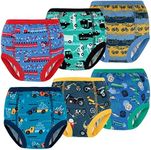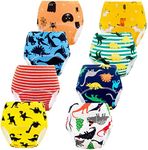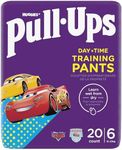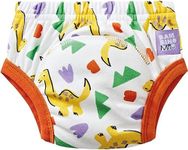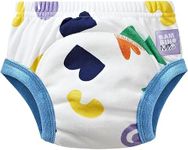Buying Guide for the Best Potty Training Pants For Toddlers
Choosing the right potty training pants for your toddler can make the transition from diapers to underwear smoother and more comfortable for both you and your child. Potty training pants are designed to help toddlers feel more independent while still providing some protection against accidents. When selecting the best potty training pants, consider factors such as absorbency, fit, material, ease of use, and design. Understanding these key specifications will help you make an informed decision that suits your toddler's needs and preferences.AbsorbencyAbsorbency refers to how much liquid the potty training pants can hold. This is important because it determines how well the pants can handle accidents without causing discomfort or mess. Potty training pants come in different levels of absorbency: light, moderate, and heavy. Light absorbency is suitable for toddlers who are almost fully potty trained and have occasional small accidents. Moderate absorbency is ideal for those who are still learning and may have more frequent accidents. Heavy absorbency is best for toddlers who are just starting potty training and need more protection. Choose the level of absorbency based on your child's current stage in potty training and their accident frequency.
FitThe fit of potty training pants is crucial for comfort and effectiveness. A good fit ensures that the pants stay in place and provide the necessary protection. Potty training pants come in various sizes, typically based on the child's weight and age. It's important to choose a size that fits snugly but is not too tight, as this can cause discomfort and restrict movement. If the pants are too loose, they may not provide adequate protection against leaks. To find the right fit, measure your child's waist and thighs and refer to the sizing chart provided by the manufacturer. Keep in mind that some brands may have different sizing standards, so always check the specific measurements.
MaterialThe material of potty training pants affects their comfort, breathability, and durability. Common materials include cotton, polyester, and blends of these fabrics. Cotton is soft, breathable, and gentle on the skin, making it a popular choice for potty training pants. Polyester is more durable and can provide better moisture-wicking properties, but it may not be as comfortable as cotton. Blended fabrics combine the benefits of both materials, offering a balance of comfort and durability. When choosing the material, consider your child's skin sensitivity and comfort preferences. Opt for hypoallergenic and breathable materials if your child has sensitive skin or is prone to rashes.
Ease of UseEase of use refers to how simple it is for both you and your toddler to put on and take off the potty training pants. This is important because it encourages independence and makes the potty training process less stressful. Potty training pants typically come in two styles: pull-up and side-snap. Pull-up pants are similar to regular underwear and can be easily pulled up and down by the toddler, promoting self-sufficiency. Side-snap pants have snaps on the sides, making them easier to remove in case of accidents, but they may require more assistance from an adult. Choose the style that best suits your child's ability to dress and undress themselves and your convenience in handling accidents.
DesignThe design of potty training pants can make them more appealing and fun for your toddler, which can encourage them to wear them willingly. Designs vary widely, from plain colors to patterns featuring popular characters and themes. Some potty training pants also have wetness indicators that change color when the pants are wet, helping your child recognize when they have had an accident. When selecting a design, consider your child's preferences and interests. Choosing pants with their favorite characters or colors can make the potty training process more enjoyable and motivating for them.


